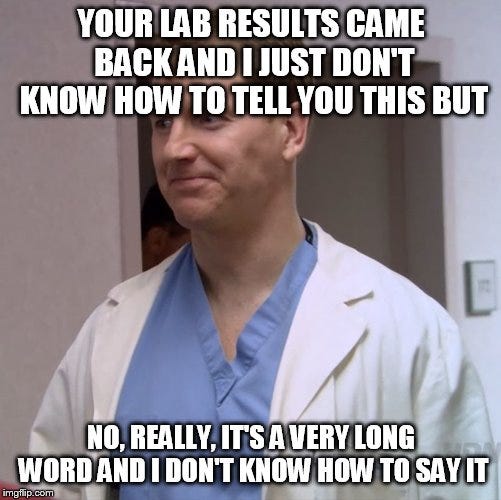Understand Your Bloodwork: A Guide For Normal People
Track these 5 markers to get an idea of where you're at.

I believe everyone should go to the doctor and get checked out. Without a baseline, you have no idea what might be brewing in that body of yours.
But now you have this report, and it’s in some strange doctor's language. What does all of this mean? Do you have to trust that the system will care for you, even if you have no idea what’s happening?
Doctor reads your results: “Ooooo, that’s not good. These babblaticons are off the chart. And look at those hemoglobular crust markers. You’ve developed Translucent Quirkiosis! We need to get you on some stratification meds immediately or you won’t last till next Tuesday without an emotional lobotifier.”
Patient clenches butthole in fear: “Okay, doctor. You know best. What do you want me to do now?”
Doctor grins: “Bend over and cover your mouth. This Blunder-Pulse Irregularity Checker might sting a little when it goes in, and I don’t want to hear you whimper.”
You could do whatever they tell you without a hint of curiosity. A better plan is to take charge of your own health.
You need to have a basic understanding of the results. Your doctor probably means well and will do his best, but it’s your life. The ultimate responsibility to stay healthy is up to you.
Let’s look at some of the biggies: Hemoglobin A1c, C-Reactive Protein (CRP), Lipid Panel, and Triglycerides. We’ll look at blood pressure, too.
Disclaimer: This is a guide for regular people, written by a normal guy. I’m not a medical professional, and none of this is medical advice. Please talk to your doctor before making any changes to your life. After you read this article, I am not to blame for anything that happens to you, and you are full of blame since you are the one responsible for yourself. Don’t read any further if you can’t be a responsible person!
1. A1c (Hemoglobin A1c)
What It Is: The average blood sugar levels over the past two to three months.
Normal Range : Below 5.7%
Prediabetes : 5.7% to 6.4%
Diabetes : 6.5% or higher
Elevated A1c indicates your blood sugar is consistently too high. This will lead to pre-diabetes and diabetes.
What they don’t tell you is that a high A1c is also a sign of chronic inflammation.
This study talks about the connection: Association between Inflammation and Biological Variation in Hemoglobin A1c in U.S. Nondiabetic Adults. There is plenty of other information that backs it up, too.
Bottom Line: A high A1c is bad. Diabetes or chronic inflammation can lead to multiple poor outcomes, including arthritis, heart disease, blindness, and amputation. So taking care of this is imperative.
2. C-Reactive Protein (CRP)
Keep reading with a 7-day free trial
Subscribe to Time2Thrive to keep reading this post and get 7 days of free access to the full post archives.




